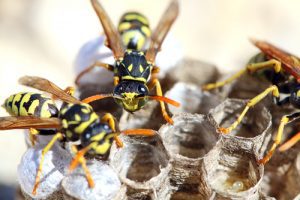Yellowjacket Nests Don’t Survive the Winter
By Chris Williams on April 27, 2011.
Q. Last summer there was a lot of yellowjacket activity in the boxwood shrubs located at my walkway. I got the impression that they were underground. I want to dig up the boxwood and plant other plants. Do you believe it’s safe to dig up these shrubs? I read somewhere that yellowjackets don’t usually come back to the same location but I’m skeptical. I don’t know if I need to call a professional or not. It has been raining quite a bit so I haven’t been able to go outside to really check to see if there is any activity. What do you suggest?
A. Although some species of yellowjackets build above-ground nests, it does sound like you were dealing with ground nesters. Go ahead and dig up those bushes, ideally before summer. Ground nesting yellowjackets die off in the winter (except in some tropical climates) and surviving queens don’t return to reuse the same nest. Last year’s yellowjacket nest should be only a memory!
About all you can see of a yellowjacket ground nest is the circular opening which is about the size of a nickel to a quarter. There may be a dirt ridge around the opening. Underground, the nest is made up of several tiers of combs, all enclosed by a papery covering.

In fall, next year’s reproductive yellowjackets develop inside the nest, then leave to mate. After mating, the males die while the fertilized queens overwinter in protected places like hollow logs, under bark, in holes in the ground, or even inside attics. Yellowjacket workers in the nest and the old queen gradually die as cold weather arrives.
Overwintering yellowjacket queens do sometimes end up starting a new nest in the same area because for some reason the conditions there may be more favorable for nesting. In early spring, you may see some yellowjacket queens scouting for nest sites.
Spring is actually a good time for your landscaping project because in spring, the old nest is “dead” and any new yellowjacket nests would be very small with just a few wasps. The nests continue to grow in size and numbers during the summer. Most of us don’t really notice yellowjackets until mid to late summer when the nests have enough workers to attract attention during their comings and goings and yellowjackets become more aggressive. By fall, a mature yellowjacket nest can have up to 5,000 workers!